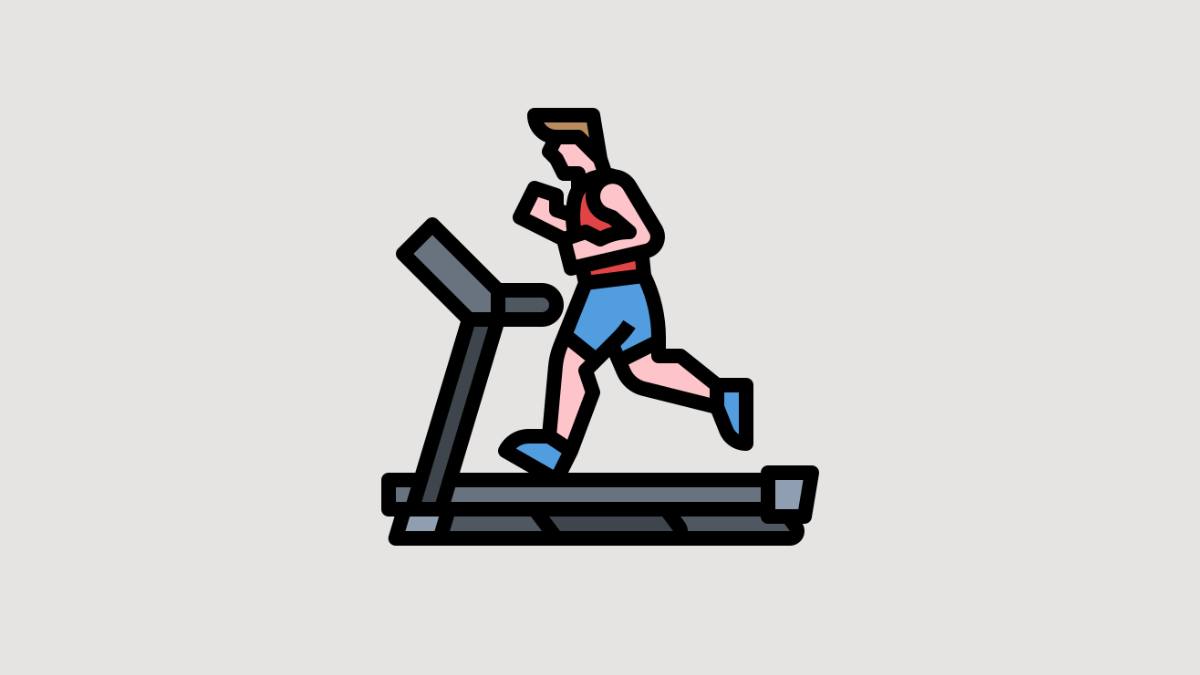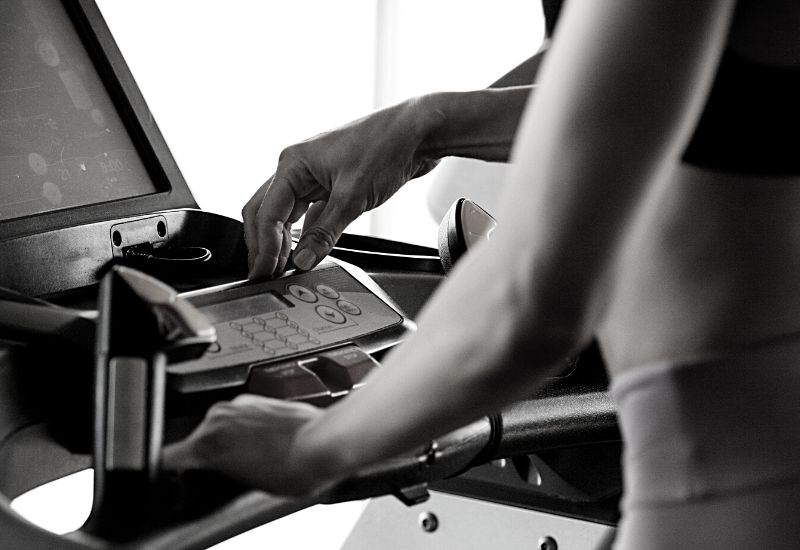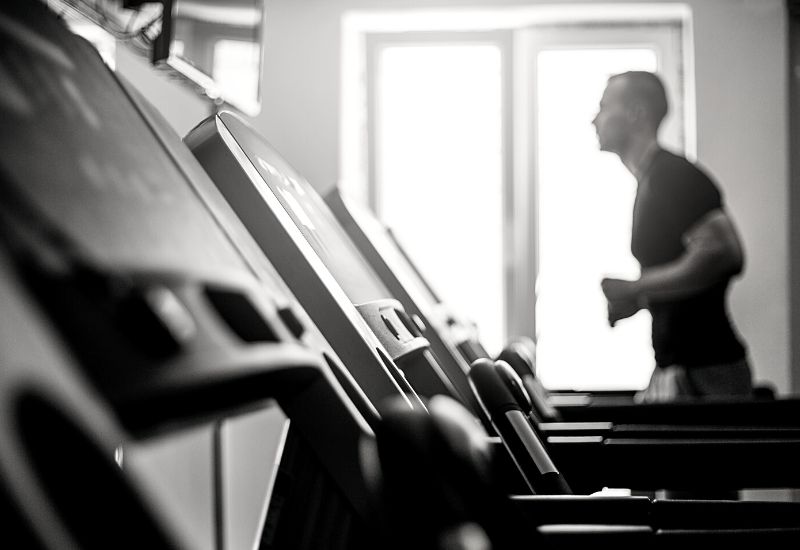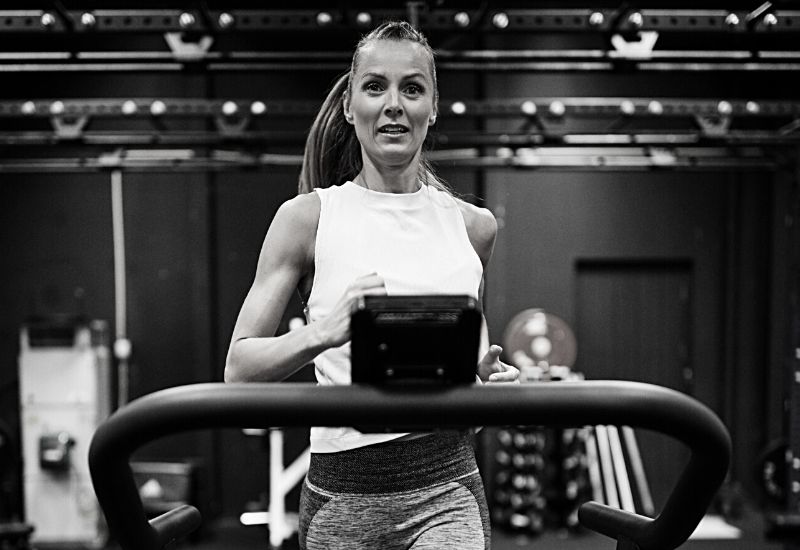
Wondering if the treadmill machine is the perfect cardio machine for your health goals? Here is a look at the top benefits of the treadmill, as well as some cons to be aware of when setting out to conquer your workout goals.
Treadmills are one of the most popular cardio machines for weight loss—and with good reason!
In fact, it’s safe to say that the treadmill delivers one of the most effective, functional workouts of any machine.
Oh, sure, it’s not a full body workout like some others (here’s looking at you, assault bike, rowing machine, and elliptical), but when it comes right down to it, none of the other cardio machines in the gym can deliver a “true to life” workout on par with the treadmill.
In this post, I want to take a few minutes to highlight the pros (and a few cons) of the treadmill, what makes it truly great for cardio workouts for beginners, and answer a few of the most commonly asked questions about treadmills.
Let’s jump in.
Health Benefits of Treadmills
Let’s start off by talking about all the good of the treadmill, what makes it a truly game-changing and highly effective cardio machine:
Benefit #1: Functional Training
If you read my rowing machine vs treadmill article, you know I’m all about functional training—specifically, any training that makes you fitter for your activities of daily life. For example, taking out the trash, playing with your kids, going for a walk with your pets, and so on.
When it comes to functional training, nothing can beat the treadmill. Not the assault bike or stationary bike, not the stair climber, definitely not the rowing machine, and, honestly, not even the elliptical.
No other cardio machine trains your body to move through the “normal” range of motion that is common in your everyday life like the treadmill.

The time you spend training on the treadmill will help you run, walk, jog, and sprint more effectively in “real life” (aka, outside the gym).
Sure, the fitness effects may not translate on a 1:1 ratio—being able to run faster/longer on a treadmill won’t always mean the exact same results on a real-life course, track, or the streets—but no other cardio machine will train you for the activity of your daily life like a treadmill.
Benefit #2: Train Anytime
For people who live in climates that are sunny and warm all year around, this isn’t a big deal. After all, you can just walk out your front door and jog, run, walk, or sprint out in the lovely weather.
But for people (like me) who live in climates that get too cold, snowy, or rainy to train outdoors, a treadmill is an absolute game-changer.
We’re able to continue our efforts to maintain our conditioning all year around, even when the weather or temperature outside is unsuitable for training. When the weather finally warms up enough that we can run, jog, or sprint outdoors, the treadmill has made it possible for us to spend months maintaining or even improving our cardiovascular conditioning, translating into more effective exercise.
Benefit #3: Amazing Cardiovascular Conditioning
Anyone who spends time running, jogging, or even walking will tell you that nothing improves your cardio better.
Think about it: your movement propels your body forward, engaging your muscles and tapping into your energy stores, forcing your body to burn calories to keep you moving. The more you train your body (on the treadmill or running/jogging outside) to maintain the energy output, the longer you are able to run, jog, walk, or sprint.

No other exercise works your cardiovascular system quite as effectively as running or jogging. Your heart works harder to pump blood to all your hard-working muscles, your lungs absorb oxygen (at a rate that is sustainable for the long-term), and your blood vessels dilate to allow that oxygenated blood to get where it needs to go.
The end result: major improvements to your cardiovascular fitness that (and I mean this literally) no other exercise can ever truly match.
Benefit #4: Track and Control Every Aspect of Your Training
One of the things that make the treadmill so great (possibly even better, in some ways, than walking outdoors) is that you have total control over your training.
- If you want to train yourself to run faster, increase the set speed by 0.1 or 0.2 MPH.
- If you want to try sprint training, set the speed to the max.
- If you want to try HIIT training (alternating between low and high-intensity intervals), you can adjust the speed accordingly.
- If you want to train different parts of your legs, you can raise and lower the incline on the treadmill.
- If you want to control exactly how far you run, how fast, and for how long, you have a built-in timer.
Training outdoors, you’ve got to run according to your terrain (existing hills, distance of a track, city blocks, running path, etc.). With the treadmill, you’re in total control of your training.
But that’s not all: you can also track your training, too.
The treadmill comes with built-in technology (such as calorie counter, heart rate monitor, accelerometer, and more) that makes it easy to monitor every second of your training.
You’ll be able to compare every session to previous performance to make sure you’re constantly improving from workout to workout.
Benefit #5: All the Health Benefits of Cardio
Like all forms of cardio, using the treadmill provides a host of pretty amazing benefits1,2,3, including (but not limited to):
- Weight loss
- Improved cardiovascular health (see above)
- Reduced risk of diabetes
- Reduced risk of heart disease
- Better mental and emotional health
- Release of feel-good endorphins and chemicals
- A boost of adrenaline to increase energy production
- Reduced cholesterol, triglycerides, and blood sugar levels
- Lower risk of cravings and snacking
- Improved sleep quality
- and so many, many more…
You’ll find that spending more time doing cardio (not just the treadmill, but any kind of cardio) is amazing for your health.
Most people are looking for calorie-burning when it comes to choosing a cardio machine, and the treadmill is an absolute boss for burning calories.
Benefit #6: Strengthen Your Bones and Joints
Running on the treadmill (and outdoors) is considered a high-impact form of exercise.
Every time you lift your feet off the ground, place them down again, and shift your weight forward as you do with the running movement, there is a certain amount of impact on your joints.
That impact will travel up your foot bones, ankles, lower legs, knees, upper legs, hips, and spine, all the way to your head—which is why you often feel tension in your lower back, shoulders, and neck when you run.
Fun Fact: There are numerous types of treadmills, and one of my favorites is curved treadmills. The main benefits of curved treadmills are reduced joint pain4 and increased oxygen absorption, making them an excellent choice for people looking for a more demanding workout without increasing joint stress.
There are several downsides to high-impact exercise (as you’ll see in the “Disadvantages of Treadmills” section), but there is a very important upside you need to know about: it makes your bones, joints, and muscles stronger.
You see, there is microscopic damage inflicted to the tissues of your bones, muscles, and joints as a result of high-impact exercise.
See also: 5 Best Cushioned Treadmills (for Comfort and Performance)
Over time, consistent damage will cause the deterioration of these tissues. But if the sufficient time elapses between high-impact workouts (usually 48+ hours), your body has time enough to repair this microscopic damage.
What’s great about this damage-and-repair cycle is that it makes your tissues stronger and is one of the reasons that a treadmill is actually a good option for people with bad knees. Your body sees the damage that is caused and repairs it not only back to its original condition, but strengthens it to make it more resilient against future damage.
The more you repeat this damage-and-repair cycle (with enough time for recovery between), the stronger the tissue becomes. Over time, your bones, joints, and muscles will be more resistant to damage and better able to endure high-impact exercise.
Benefit #7: Easy Entertainment
Last, but definitely not least, I like the treadmill because it’s so easy to stay entertained while training.
Most types of treadmills come with a tablet holder or phone cradle of some sort, a place where you can put your favorite mobile device while you train. This holder/cradle allows you to watch TV, read a book, listen to music or a podcast, or entertain yourself throughout the exercise.
Or, because the treadmill is a fairly quiet machine, you can watch TV or a movie on an existing TV screen in your home gym (or your commercial gym).

This isn’t the best reason to use the treadmill, but for people (like me) who tend to get bored easily while working out, it’s definitely a factor to consider.
I’ve run for hours at a time because I got sucked into a great scene in the book I’m reading, done one more round of sprint training because I was interested in some podcast, or ran just a little longer to finish my session in time with the end of a movie or TV show.
It’s easier to distract yourself while training with a treadmill with a screen and thus avoid the boredom that makes it so easy to bail on your workout prematurely.
Disadvantages of Treadmills
As with any cardio machine in the gym, there are a couple of downsides you need to know about.
None of them are deal-breakers, but they are certainly factors to keep in mind as you consider what to do when training, or which cardio machines to purchase for your home gym.
Disadvantage #1: High-Impact Exercise
Like I mentioned above, running and jogging are both high-impact forms of exercise. When done correctly (with sufficient rest between), they can strengthen your bones, joints, and muscle tissue.
However, if you use the treadmill daily with no rest, you can contribute to wear and tear on your joints. The joints most commonly affected by over-training on the treadmill are:
- Ankles
- Knees
- Hips
- Lower back
However, you may find that your neck, shoulders, or even your elbows are affected by the high-impact training (especially if they’re already injured).
New trainees will want to lean into running by starting out with treadmill walking to help build up the strength of their joints.
Disadvantage #2: One Type of Exercise
With the treadmill, there’s really no variety. The only thing that changes is how fast you train—walk, speed up to jog, speed up more to run, or go full speed to sprint.
There’s also no real variety in your surroundings. You’re going nowhere, just reading on a machine that stays stationary and keeps you in the same place in the gym.
For many people, the lack of variety in both their training options and their environment leads them to get bored on the treadmill far quicker than with other cardio machines or outdoor training methods.
Disadvantage #3: Large and Bulky
If you’ve seen a treadmill, you know exactly what I’m talking about.
Many treadmills are designed to fold up when not in use, but even when folded (or standing up), they still have a footprint easily 30+ inches wide and 20+ inches long, not to mention anywhere from 50 to 70 inches tall.
When unfolded and in position to use, they can take up easily 60+ inches of length, with that same 30+ inches of width.
They’re far from the most compact of the cardio machines, which may make them unsuitable for your home workout setup if you’re dealing with a limited amount of space.
Health Benefits of Treadmills – FAQs
Are treadmills an effective cardio machine for losing weight?
Thanks to their truly amazing cardiovascular conditioning, it’s safe to say the treadmill is one of the top three machines for losing weight.
With the treadmill, you’re moving your entire body weight, so strengthening your skeletomuscular system (bones, muscles, and joints) to more efficiently move your own body weight. And because your muscles have to propel your whole body forward, it burns more energy per minute than many other forms of cardio.
There’s a reason that jogging and running are considered the best exercise for weight loss—and the same holds true whether you jog/run on the street, at a park, or on the treadmill.
How many minutes can you spend on a treadmill each day?
Ideally, your goal should be to spend at least 20+ minutes every time you step onto the treadmill.
Your body takes about 10-15 minutes of low-intensity, steady-state exercise to switch from burning only glucose-based energy to burning both glucose- and fat-based energy. The longer you spend training (30, 45, or 60 minutes), the more fat you’ll burn.
More time spent training on the treadmill will also enable your body to walk, run, and jog for longer when out in the real world.
There’s really only one exception to this rule: HIIT/sprint training. With this high-intensity method of training, you won’t be able to sustain the exertion for more than 20 minutes at a time. Add in your warm-up before and cool-down after, and you’ve got yourself a cool 30 minutes training on the treadmill.
But remember: DO NOT train on the treadmill every day. Give your body at least one day of rest between high-impact workouts to ensure your bones, joints, and muscle tissue have time to repair.
The Bottom Line
When it comes to effective training, you just can’t beat the treadmill!
No other workout moves your entire body as efficiently. No other cardio workout engages your cardiovascular system as completely. And no other workout is as functional and good for your overall activities of daily life like treadmill training.
Be smart and spend more time on the treadmill; it’ll make you a fitter, more active person in every aspect of your life.
More Treadmill Machine Guides
5 Best Treadmill Workouts for Weight Loss (Plus Tips for Turbocharged Weight Loss). Looking for some killer treadmill workouts for weight loss? Here are five weight loss workouts you can do on the treadmill, plus some tips for getting the most of your time on the treadmill.